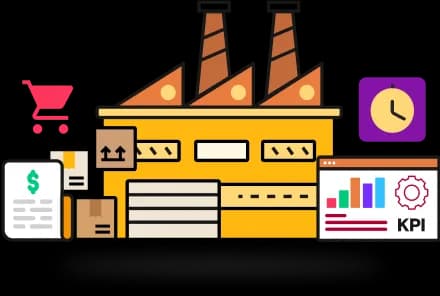Industry
Industrial Manufacturing
High Tech & Electronics
Footwear Manufacturing
Apparel & Textiles
Food & Beverage
Rubber & Plastics
Metal Fabrication
Industrial Machinery & Equipment
Construction & Engineering
Furnitures & Fixtures
Medical Device Manufacturing
Automotive Manufacturing
Aerospace And Defence
Screw Shop Manufacturing
Spring Shop Manufacturing
Solutions
Pricing
Resources
Company
Deskera Calculators
Check out the basic tools that help calculate the most common ERP functions and are handy for gauging and maintaining financial health!

Cost of Goods Sold
Cost of Goods Sold (COGS) refers to the direct costs associated with producing goods or services that a company sells during a specific period. These costs typically include the cost of materials, labor, and overhead directly attributable to the production process. Calculating COGS accurately is crucial for determining a company's gross profit and understanding its operational efficiency. Companies often track COGS closely as it directly impacts their profitability and financial performance.
Break Even
A breakeven calculator helps determine the point at which a business's total revenue equals its total costs, resulting in neither profit nor loss. To calculate the breakeven point, you need to know fixed costs, variable costs per unit, and the selling price per unit.
Days in Inventory
To calculate the days in inventory, you need to know the average inventory level and the cost of goods sold (COGS). Here's the formula: Days in Inventory = (Average Inventory / COGS) * 365. Here's a step-by-step guide on how to calculate it: Determine the average inventory level. This can be calculated by adding the beginning inventory to the ending inventory and dividing by 2. It represents the average amount of inventory held during a specific period.
Acid Test Ratio
The Acid-Test Ratio, also known as the Quick Ratio, is a liquidity ratio that measures a company's ability to meet its short-term obligations with its most liquid assets. It excludes inventory from the calculation because inventory can sometimes be difficult to convert quickly into cash.
Ending Inventory
To calculate the ending inventory, you typically need to know the beginning inventory, purchases or production during the period, and any goods sold or used. The formula for ending inventory is: Ending Inventory = Beginning Inventory + Purchases or Production - Cost of Goods Sold. If you're dealing with a more complex situation, like when using the FIFO (First In, First Out) or LIFO (Last In, First Out) inventory valuation methods, the calculation can vary.
Gross Domestic Product
Calculating Gross Domestic Product (GDP) involves adding up the total value of all goods and services produced within a country's borders over a specific period, typically a year or a quarter. There are three primary methods to calculate GDP...
Assets Depreciation Per Year
To calculate the depreciation of an asset per year, you need to know the initial cost of the asset, its estimated useful life, and the depreciation method being used. The most common depreciation methods are straight-line depreciation, declining balance depreciation, and units of production depreciation.
Solvency Ratio
The solvency ratio measures a company's ability to meet its long-term obligations. It indicates the proportion of a company's assets that are financed by equity versus debt. The two most common solvency ratios are the debt-to-equity ratio and the debt ratio.
Cost of Discount Lost
The cost of discount lost refers to the additional expense a company incurs when it fails to take advantage of a cash discount offered by its suppliers for prompt payment.
Insolvency Ratio
An Insolvency Ratio is a financial metric used to determine the ability of a company to meet its long-term obligations. It is typically calculated using the formula...
Return on Capital Employed
Return on Capital Employed (ROCE) is a financial metric that measures a company's profitability and the efficiency with which its capital is employed.
Economic Order Quantity
Economic Order Quantity (EOQ) is a formula used in inventory management to determine the optimal order quantity that minimizes the total cost of inventory, including ordering and holding costs.
Beginning Inventory
Beginning Inventory is a critical component in calculating the Cost of Goods Sold (COGS) and in managing inventory effectively. It represents the value of inventory that a company has at the start of an accounting period.

Deskera Products
Our products form the heart of our endeavor, evolving continually with extensive research insights and technological prowess to keep pace with the ever-changing business landscape. Our commitment ensures that your business stays at the forefront, never lagging behind.
Connect e-commerce portals, point-of-sale devices, payment gateways, automation platforms, and shipment tracking tools with out-of-the-box integrations.
Run Your Business With Deskera

Products
Use Cases
 , India
, India  , Singapore
, Singapore  , and Canada
, and Canada  with
with 




